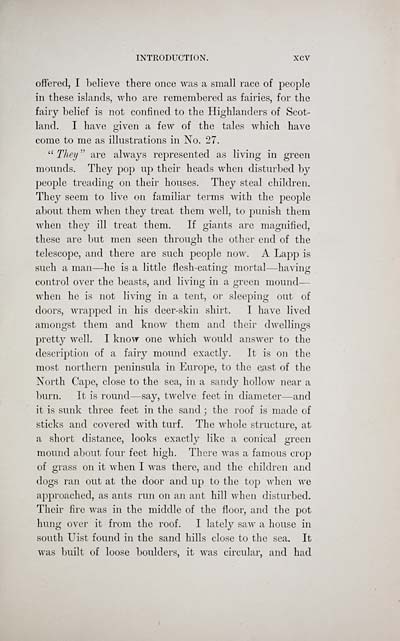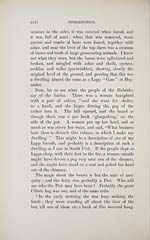Download files
Complete book:
Individual page:
Thumbnail gallery: Grid view | List view

INTRODUCTION. XCV
offered, I believe there once was a small race of people
in these islands, who are remembered as fairies, for the
fairy belief is not confined to the Highlanders of Scot-
land. I have given a few of the tales which have
come to me as illustrations in No. 27.
" They " are always represented as living in green
mounds. They pop up their heads when disturl^ed by
people treading on their houses. They steal children.
They seem to live on familiar terms with the people
about them when they treat them well, to punish them
when they ill treat them. If giants are magnified,
these are but men seen through the other end of the
telescope, and there are such people now. A Lapp is
such a man — he is a little flesh-eating mortal — having
control over the beasts, and living in a green mound —
when he is not living in a tent, or sleeping out of
doors, wrapped in his deer-skin shirt. I have lived
amongst them and know them and their dwellings
pretty well. I know one which would answer to the
description of a fairy mound exactly. It is on the
most northern peninsula in Europe, to the e^st of the
North Cape, close to the sea, in a sandy hollow near a
burn. It is round — say, twelve feet in diameter — and
it is sunk three feet in the sand ; the roof is made of
sticks and covered with turf. The whole structure, at
a short distance, looks exactly like a conical green
mound about four feet high. There Avas a famous crop
of grass on it when I was there, and the children and
dogs ran out at the door and up to the top Avhen we
approached, as ants run on an ant hill when disturbed.
Their fire was in the middle of the floor, and the pot
hung over it from the roof. I lately saw a house in
south Uist found in the sand hills close to the sea. It
was built of loose boulders, it was circular, and had
offered, I believe there once was a small race of people
in these islands, who are remembered as fairies, for the
fairy belief is not confined to the Highlanders of Scot-
land. I have given a few of the tales which have
come to me as illustrations in No. 27.
" They " are always represented as living in green
mounds. They pop up their heads when disturl^ed by
people treading on their houses. They steal children.
They seem to live on familiar terms with the people
about them when they treat them well, to punish them
when they ill treat them. If giants are magnified,
these are but men seen through the other end of the
telescope, and there are such people now. A Lapp is
such a man — he is a little flesh-eating mortal — having
control over the beasts, and living in a green mound —
when he is not living in a tent, or sleeping out of
doors, wrapped in his deer-skin shirt. I have lived
amongst them and know them and their dwellings
pretty well. I know one which would answer to the
description of a fairy mound exactly. It is on the
most northern peninsula in Europe, to the e^st of the
North Cape, close to the sea, in a sandy hollow near a
burn. It is round — say, twelve feet in diameter — and
it is sunk three feet in the sand ; the roof is made of
sticks and covered with turf. The whole structure, at
a short distance, looks exactly like a conical green
mound about four feet high. There Avas a famous crop
of grass on it when I was there, and the children and
dogs ran out at the door and up to the top Avhen we
approached, as ants run on an ant hill when disturbed.
Their fire was in the middle of the floor, and the pot
hung over it from the roof. I lately saw a house in
south Uist found in the sand hills close to the sea. It
was built of loose boulders, it was circular, and had
Set display mode to: Large image | Transcription
Images and transcriptions on this page, including medium image downloads, may be used under the Creative Commons Attribution 4.0 International Licence unless otherwise stated. ![]()
| Early Gaelic Book Collections > Matheson Collection > Popular tales of the west Highlands > Volume 1 > (115) |
|---|
| Permanent URL | https://digital.nls.uk/81388608 |
|---|
| Description | Volume I. |
|---|---|
| Shelfmark | Mat.74 |
| Additional NLS resources: | |
| Attribution and copyright: |
|
| Description | Items from a collection of 170 volumes relating to Gaelic matters. Mainly philological works in the Celtic and some non-Celtic languages. Some books extensively annotated by Angus Matheson, the first Professor of Celtic at Glasgow University. |
|---|
| Description | Selected items from five 'Special and Named Printed Collections'. Includes books in Gaelic and other Celtic languages, works about the Gaels, their languages, literature, culture and history. |
|---|

